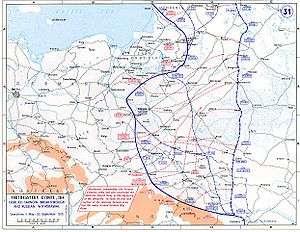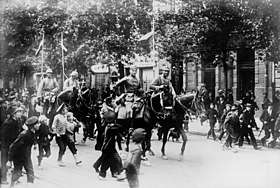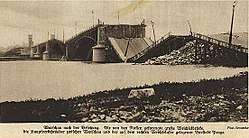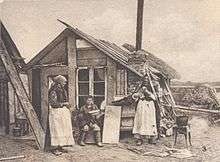Great Retreat (Russian)
The Great Retreat was a strategic withdrawal on the Eastern Front of World War I in 1915. The Imperial Russian Army gave up the salient in Galicia and Poland. The Russians' critically under-equipped and (at the points of engagement) outnumbered forces suffered great losses in the Central Powers' July–September summer offensive operations, this leading to the Stavka ordering a withdrawal to shorten the front lines and avoid the potential encirclement of large Russian forces in the salient. While the withdrawal itself was relatively well conducted, it was a severe blow to Russian morale.
| Great Retreat | |||||||||
|---|---|---|---|---|---|---|---|---|---|
| Part of the Eastern Front of World War I | |||||||||
 Russian withdrawal in 1915. | |||||||||
| |||||||||
| Belligerents | |||||||||
|
|
| ||||||||
| Commanders and leaders | |||||||||
|
|
| ||||||||
| Strength | |||||||||
|
1,136,000 4,650 field guns in German sector[1] |
1,200,000 6,000 field guns 9,300 fortress guns[2] | ||||||||
| Casualties and losses | |||||||||
|
430,800+ Germany: 200,000 casualties[3] Austria Hungary: 230,800+ casualties[4] |
1,500,000 500,000 killed or missing 1,000,000 captured 9,300 fortress guns captured[5] | ||||||||
Background
During this period, the buildup of forces generally favoured the Central Powers. Four new German armies, the 11th, 12th, Army of the Niemen and Army of the Bug were formed. Given the steady erosion of the Russian armies' combat power due to a poorly administered system of reinforcement, particularly of officers, this dramatically shifted the balance of power in the eastern theatre to the Central powers as 13 Central Powers armies faced nine under-strength Russian armies. Under pressure from the Kaiser, Falkenhayn gave in to Hindenburg and Ludendorff's insistence on an offensive in the region. Although Ludendorff and Austro-Hungarian General Staff Chief Conrad von Hötzendorf favored an encirclement operation (attacking the extreme north-east and south-east of the salient), just as the Stavka feared, Falkenhayn vetoed this on the grounds of the Central Powers' logistical limitations which confined them to slow advances along major railway lines.
Commanders of the Russian Field Armies in Poland had already worked to persuade the Stavka to order a withdrawal from the salient, but the Stavka had felt unable to take such a bold move due to the political implications. The Stavka also did not permit tactical withdrawals within the salient such as the Second Army's proposal to withdraw behind the Vistula, forcing the field armies to hold tactically disadvantageous or even indefensible positions.
Offensive
Despite heavy initial resistance, the Gorlice–Tarnów Offensive of May–June eventually resulted in a series of tactical breakthroughs and Mackensen's armies crossed the San River and re-took the Austro-Hungarian fortress at Przemyśl, the Russians leaving the Galician capital of Lvov on 22 June. At this point the Stavka began planning a retreat from the Poland salient as the Russians's forces in southern Poland withdrew northward to a new defensive line anchored on the Vistula river and the fortress of Ivanovgrod. Between 23 and 27 June the Germans established bridgeheads across the Dniester to the south, but were halted by Russian counterattacks from the east in July.
More worryingly for the Stavka, the German Tenth and Niemen armies pressed through on the extreme north end of the line in Courland. Although there was nothing worth defending in the area, the Stavka felt pressured to defend it on principle and so created a new army to defend the region. When this army was defeated and pushed back from Courland, the Stavka's over-estimation of the Germans logistical capabilities led to him fearing that these advances could be used as a springboard for further advances. It was feared that further successful advances in the north, combined with a fresh offensive in the south, could lead to the encirclement of the entire Poland-salient. Over-estimation of German naval capabilities also led to fears of an offensive thrust through Pskov to Petrograd with the aid of amphibious landings in the capital itself.
Due to heavy losses in the Gorlice–Tarnów Offensive the Russian Army as a whole was a million combat troops, roughly 30%, short of its nominal strength of 1.8 million combat troops as well as being in an exposed position in the Poland Salient.
The Russian field armies at this time were critically short of modern weapons and ammunition of all kinds—artillery, machine guns, and even rifles. In the words of David Lloyd George, then the British Minister of Munitions, "The Russians, with their inferior equipment and serious shell deficiency, were quite unable to reply. Retreat was the only expedient open to them to save their armies from complete destruction."[6]
The obsolescent fortresses of Novogeorgievsk, Ivangorod, Grodno, Osowiec, and Dvinsk, that were on or near the front lines at the time, contained considerable artillery, including some modern types. It was hoped that these could compensate for the temporary weakness of the infantry and render the Ivangorod-Lublin-Chełm line defensible.
On 13 July, the Central Powers' armies opened a new offensive across the entire front. By 17 July the forces Gallwitz's forces in the center-north had taken 80% losses, and although they had only been forced back only some 8 km (5 mi), they had to retreat across the Narew to avoid total annihilation. German advances in the far north in Latvia and Lithuania took the fortress of Grodno in a matter of days, when the Stavka had assumed that it could hold for weeks at the least, and with the renewal of Austro-Hungarian attacks in the south the Stavka now believed that the encirclement of the Poland-salient was inevitable without an immediate withdrawal and so ordered the abandonment of the defensive lines along the Narew and Vistula, trusting that the fortresses could cover the retreat of its forces.

By 13 July, the entire southern wing had been pushed back another 160 km (99 mi) to the Bug River, leaving only a small portion of Congress Poland in Russian hands, anchored on Warsaw and the Ivangorod fortress. On 22 July, armies of Central Powers crossed the Vistula river. In August, the Russian Fourth army left the Ivangorod fortress. With the continuing Russian retreat, Warsaw became isolated, and the German 12th Army (under Gallwitz) seized the opportunity and conquered it on 4–5 August.

New attacks by the German Eighth, Tenth and Twelfth armies moving south out of Prussia soon caused even this front to collapse, sending the entire northern end of the Russian lines streaming backward, eventually forming a line running north–south at about the pre-war eastern Prussian border.
The Germans, after having received considerable reinforcements, took Brest-Litovsk on 25 August. On 19 September, Hindenburg's forces captured Vilna.
Aftermath
With their troops starving and their forces critically under-strength due to battle-casualties and particularly disease, the German advance was halted by Russian counter-attacks in late September. The new frontline ran from the Baltic sea to the Romanian border by way of the Belarusian forests and disease-ridden Pripyet Marshes. The new line was roughly on the line of Riga-Jakobstadt-Dünaburg-Baranovichi-Pinsk-Dubno-Ternopil.
On 21 August, Tsar Nicholas II took advantage of the Stavka's blunders, in losing so many troops to the Central Powers' summer offensives and then retreating only when it was too late, to effectively neuter its power by removing Grand Duke Nicholas Nikolaevich from his post as its head, taking direct control of the army.
Russian terror and atrocities against civilians

As the Russian army retreated, the Chief of the General Staff Nikolai Yanushkevich, supported by Grand Duke Nicholas, ordered the army to devastate the border territories and expel the "enemy" nations within.[7][8] The Russian authorities launched pogroms against German populations in Russian cities, massacred Jews in their towns and villages and deported 500,000 Jews and 250,000 Germans into the Russian interior.[8] On 11 June, a pogrom began against Germans in Petrograd, with over 500 factories, stores and offices looted and mob violence unleashed against Germans.[8] The Russian military leadership regarded Muslims, Germans and Poles as traitors and spies, while Jews were considered political unreliables.[7]
See also
Citations
- Norman Stone, The Eastern Front, 1975, p.191
- Norman Stone, The Eastern Front, 1975, p.174
- Richard L. DiNardo, 2010, p. 132-133
- Österreich-Ungarns letzter Krieg Band III, Wien 1932, S. 163
- Norman Stone, The Eastern Front, 1975, p.191
- Lloyd George, David. War Memoirs of David Lloyd George. Vol. 1. London: Ivor Nicholson & Watson, 1933. p. 451-52.
- Baberowski & Doering-Manteuffel 2009, pp. 202-203.
- McMeekin 2017, p. 68.
Bibliography
- Baberowski, Jörg; Doering-Manteuffel, Anselm (2009). Geyer, Michael; Fitzpatrick, Sheila (eds.). Beyond Totalitarianism: Stalinism and Nazism compared. Cambridge University Press. ISBN 978-0-521-89796-9.CS1 maint: ref=harv (link)
- McMeekin, Sean (2017). The Russian Revolution: A New History. London: Basic Books. ISBN 978-0-46503-990-6.CS1 maint: ref=harv (link)
Further reading
- Johnson, Douglas Wilson (1916). "The Great Russian Retreat". Geographical Review. American Geographical Society. 1 (2): 85–109. doi:10.2307/207761. JSTOR 207761.
- Norman Stone, The Eastern Front 1914-17 (London, 1975) pp. 165–193
- Stanley Washburn. Victory in defeat; the agony of Warsaw and the Russian retreat
- Stanley Washburn. The Russian campaign, April to August, 1915